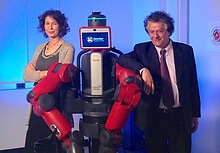Aloimonos and Fermüller Imagine the Future of Microrobots in Science Robotics Article

Two University of Maryland computer vision experts recently imagined the future of insect-scale, active vision sensing systems in a commentary article published on July 15 in Science Robotics.
“A Bug’s Eye View” was authored by Cornelia Fermüller (left in photo), an associate research scientist in the University of Maryland Institute for Advanced Computer Studies (UMIACS), and Yiannis Aloimonos (right), a professor computer science with an appointment in UMIACS.
In their commentary, the two Maryland faculty considered the ramifications of research that was highlighted in another article appearing in the same issue. That piece, “Wireless Steerable Vision for Live Insects and Insect-Scale Robots,” discussed a wireless, Bluetooth-enabled, low-power, rotatable vision system that can be mounted on insect-scale robots and live insects.
It demonstrated how it is now feasible to equip insect-scale robots with an “active vision” system that allows scene selection, manipulation of the field of vision, and a capability to zoom the camera.
Aloimonos and Fermüller noted that this was a superior system to existing microrobot schemes that rely on fixed parameters.
Because of their size, weight, area and power constraints, tiny robots currently cannot reconstruct scenes using simultaneous localization and mapping (SLAM) algorithms, the Maryland researchers said. What the other researchers had done was to create an alternative—a steerable camera system that can perform a specific set of tasks in a more optimal way.
Aloimonos and Fermüller then imagined a future in microrobots where steerable cameras could find holes, successfully fly through them, avoid obstacles, and recognize a variety of objects without computing 3D world models—a distinct alternative to SLAM.
“If the insect robotics community succeeds with this SLAM alternative,” they wrote, “then the results will permeate all robotics.”
In addition to their appointments in UMIACS, Aloimonos and Fermüller are active in the Maryland Robotics Center and the Institute for Systems Research, which published a news article that this brief is adapted from.
